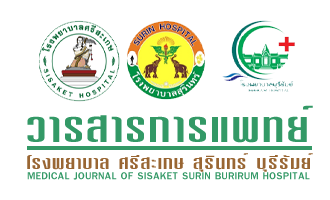ผู้ป่วยที่เสียชีวิตด้วยโลหิตเป็นพิษจากชุมชน ในโรงพยาบาลศรีสะเกษ พ.ศ. 2547
Main Article Content
บทคัดย่อ
หลักการและเหตุผล: ภาวะโลหิตเป็นพิษ(sepsis) เป็นสาเหตุการตายอันดับที่หนึ่งในโรงพยาบาลศรีสะเกษใน ปี พ.ศ. 2547 ส่วนใหญ่เป็นโลหิตเป็นพิษจากชุมชน (community acquired sepsis) การศึกษาในครั้งนี้เพื่อรวบรวมข้อมูลไปวางแผนปรับปรุงประสิทธิภาพในการดูแลผู้ป่วยต่อไป
วัตถุประสงค์: เพื่อศึกษาลักษณะทั่วไปและลักษณะทางคลินิก ของผู้ป่วยที่มาด้วยภาวะโลหิตเป็นพิษจากชุมชน และเสียชีวิตที่โรงพยาบาลศรีสะเกษในปีงบประมาณ 2547
วิธีการวิจัย: การวิจัยเชิงพรรณนา โดยทำการศึกษาย้อนหลังจากเวชระเบียนผู้ป่วยที่เสียชีวิตที่ได้รับการวินิจฉัยว่าเป็น ภาวะโลหิตเป็นพิษ(sepsis) ตั้งแต่แรกรับจากแพทย์โรงพยาบาลศรีสะเกษ โดยวินิจฉัยจากประวัติ ตรวจร่างกาย การตรวจเลือดและการเพาะเชื้อเลือด ซึ่งเข้าได้กับหลักเกณฑ์การวินิจฉัยภาวะโลหิตเป็นพิษ2 ตั้งแต่ 1 ตุลาคม 2546 ถึง 31 กันยายน 2547 โดยศึกษาข้อมูลพื้นฐานทั่วไป ลักษณะอาการทางคลินิก ปัจจัยเสี่ยง โรคที่เกิดร่วมภาวะ แทรกซ้อน ยาปฏิชีวนะที่ใช้ ภาวะแทรกซ้อนหลักที่ทำให้เสียชีวิต ผลการตรวจทางห้องปฏิบัติการ และค่าใช้จ่ายในการรักษา
ผลการศึกษา: มีผู้ป่วยที่เช้าได้กับหลักเกณฑ์วินิจฉัยภาวะโลหิตเป็นพิษ 173 ราย เป็นชาย 76 คน หญิง97 คน อายุเฉลี่ย 59ปี (ตั้งแต่ อายุ 2-96ปี) ช่วงเดือนที่พบผู้ป่วยมากคือเดือนเมษายน - มิถุนายน ผู้ป่วยมีโรคประจำตัวหรือปัจจัยเสี่ยงต่อการเกิดการติดเชื้อและภาวะโลหิตเป็น พิษ 76.30% อาการที่พบมากในผู้ป่วยคือไข้และหนาวสั่นและความผิดปกติจากตรวจนับเม็ดเลือด CBC พบ Leukocytosis ตำแหน่งการติดเชื้อที่เป็นสาเหตุของภาวะโลหิตเป็นพิษพบมากที่ระบบทางเดินหายใจ34.10% รองลงมาคือระบบทางเดินอาหาร31.21% ผลการเพาะเชื้อจากเลือดพบเชื้อ 22 ราย (25.88%) เชื้อที่พบมาก คือ Burkholderiapseudomallei 59.0% ความรุนแรงของภาวะโลหิตเป็นพิษภายในวันแรกของการรักษาเป็น ภาวะโลหิตเป็นพิษช็อก(septicshock)และภาวะโลหิตเป็นพิษช็อกที่ไม่ตอบสนอง (refractory septic shock) 59.53% ภาวะแทรกซ้อนที่พบบ่อยคือระบบทางเดินหายใจ66.47% รองลงมาคือภาวะไตวายเฉียบพลัน 64.16% ยาปฏิชีวนะที่มีการใช้มากคือ Ceftriaxone63.0% รองลงมาเป็นCeftazidime35.83% ภาวะแทรกซ้อนหลักที่ทำให้เสียชีวิตคือ ช็อก 92.48% รองลงมาคือภาวะAcute respiratory distress syndrome 10.40% ผู้ป่วยส่วนใหญ่เสียชีวิตใน 1 วัน 59.53% ค่าใช้จ่ายต่อราย เฉลี่ย 16,991.45 บาท (พิสัยตั้งแต่ 980-111,989 บาท)
สรุป: ผู้ป่วยที่เสียชีวิตด้วยโลหิตเป็นพิษจากชุมชนพบมากในผู้ป่วยที่มีอายุมาก,ปัจจัยเสี่ยงและโรคประจำตัว ลักษณะอาการที่พบมีความรุนแรงมากและการดำเนินโรคที่เร็ว พบภาวะ แทรกช้อนมากโดยเฉพาะระบบทางเดินหายใจ เชื้อที่พบมากคือ Burkholderiapseudomalleiภาวะแทรกช้อนหลักที่ทำให้เสียชีวิตคือ ช็อก ผู้ป่วยโลหิตเป็นพิษจาก ชุมชนที่มีอายุมาก,ปัจจัยเสี่ยงและโรคประจำตัวและความรุนแรงของโรคมากตั้งแต่แรก ควรรีบให้การประเมินและการรักษาโดยมีการเฝ้าระวังติดตามอย่างใกล้ชิด
Article Details
เอกสารอ้างอิง
2. อมร สีลารัศมี. Sepsis Syndrome, An Update on Infectious Disease.กรุงเทพฯ: สมาคมโรคติดเชื้อแห่งประเทศไทย, 2548:หน้า 68-99.
3. ธีรพงษ์ ตัณฑวิเชียร. Septic shock. ใน: วิทยา ศรีดามา(บรรณาธิการ) Emergency Medicine. กรุงเทพฯ : ภาควิชาอายุรศาสตร์ คณะแพทยศาสตร์ จุฬาลงกรณ์มหาวิทยาลัย, 2544:หน้า 175-94.
4. Spie CD, Von Dossow V, Eggers V, et al. Altered cell-mediated immunity and increased postoperative infection rate in long-term alcoholic patients. Anesthesiology. 2004 May;100(5):1088-100. Available from : URL : https://www.ncbi.nlm.nih.gov /entrez/query. fcgi?CMD=search&DB=pubmed
5. Von Dossow V, Schilling C, Beller S, et al Altered immune parameters in chronic alcoholic patients at the onset of infection and of septic shock. Crit Care. 2004 Oct;8(5):R312-21. Epub 2004 Jul 20. Available from:URL : https://www.ncbi.nlm.nih.gov /entrez/query.fcgi?CMD=search&DB=pubmed
6. American College of Chest Physicians/ Society of Critical Care Medicine, Consensus Conference: Definitions of sepsis and organ failure and guidelines for the use of innovative therapies in sepsis. Crit Care Med 1992;20:864.
7. อภิรักษ์ ปาลวัฒน์วิไชย, ดุสิต สถาพร, อดิศร วงษา. ARDS(Acute Respiratory Distress Syndrome). ใน: สุชัย เจริญรัตนกุล (บรรณาธิการ). อุรเวชช์ร่วมสมัย. กรุงเทพฯ : สมาคมอุรเวชช์ แห่งประเทศไทย; 2538. หน้า 133-52.
8. สมาคมโรคไตแห่งประเทศไทย. แนวทางการสืบค้นการปรากฏของโปรตีนในปัสสาวะ. ใน: วิทยา ศรีดามา(บรรณาธิการ). Evidence-Base Clinical Practice Guideline ทางอายุรกรรม2548. กรุงเทพฯ : ภาควิชาอายุรศาสตร์คณะแพทยศาสตร์ จุฬาลงกรณ์มหาวิทยาลัย. หน้า99-104.
9. Bradley MD, Barry MB. Cardinal manifestations of renal disease. In:Anthony SF, Eugene B, Kurt JI, et al , editors. Harrison’s principle of internal medicine. 14th ed. USA:R.R.Donnelley and Sons, Inc; 1998. p. 258-61.
10. Ispahani P, Pearson NJ, Greenwood D. An analysis of community and hospital acquired bacteremia in a large teaching hospital in the United Kingdom. Q J Med 1987;63:427-40.
11.Lertpattanasuwan N. Community Acquired Bacteremia in Sisaket Hospital a 1-Years Prospective Study. Med J SisaketSurinBuriram Hosp 2004;19(1):43-59.
12. Zahorec R, Firment J, Strakova J, et al. Epidemiology of severe sepsis in intensive care units in the Slovak Republic. :Infection. 2005 Jun ; 33(3):122-8. Available from: URL: https://www.ncbi.nlm.nih.gov/entrez/query.fcgi?CMD=search&DB=pubmed.
13. Adrie C, Alberti C, Chaix-Couturier C, et al. Epidemiology and economic evaluation of severe sepsis in France: age, severity, infection site, and place of acquisition (community, hospital or intensive care unit) as determinants of workload and cost. J Crit Care. 2005 Mar;20(l):46-58. Available from: URL: https://www.ncbi.nlm.nih.gov/ entrez/query.fcgi?CMD=search&DB=pubmed.
14. Wheeler AP, Bernard GR. Treating patients with severe sepsis. N Engl J Med 1999;340:207-14.
15. Leone M, Bourgoin A, Cambon S, et al. Empyrical antimicrobial therapy of septic shock patients: adequacy and impact on the outcome. Crit Care Med. 2003 Feb;31(2):648-50.
16. Sands KE, Bates DW, Lanken PN, et al. Epidemiology of sepsis syndrome in 8 academic medical centers. JAMA 1997;278:234.
17. Rangel-Frausto MS, Pittet D, Costigan M, et al. The natural history of the systemic inflammatory response syndrome (SIRS).A prospective study. JAMA 1995;273:117.
18. Connors AF Jr, Speroff T, Dawson NV, et al. The effectiveness of right heart catheterization in the initial care of critically ill patients. JAMA 1996;276:889-97.
19. Opal SM, Cross AS. Clinical trials for severe sepsis ะ past failure and future hopes. Infect Dis Clin North Am 1999;13:285-97.
20. Hayes MA. Timmins AC, Yau EHS, et al. Elevation of systemic oxygen delivery in the treatment of critically ill patients. N Engl J Med 1994;330:1717-22.
21. Rivers E, Nguyen B, Havstad S, et al. Early goal-directed therapy in the treatment of severe sepsis and septic shock. N Engl J Med 2001;345:1368-77.
22. Robert WS, Wei W. Acute renal failure and sepsis. N Engl J Med 2004;351:159-69.
23. Kieft H, Hoepelman AIM, Zhou W, Rozenberg-Arska M, Struyvenberg A, Verhoef J. The sepsis syndrome in a Dutch university hospital: clinical observations. Arch Intern Med 1993;153:2241-247.
24. Bernard GR, Wheeler AP, Russell JA, et al. Effects of ibuprofen on the physiology and survival of patients with sepsis. N Engl J Med 1997;336:912-18.
25. Welte T. Sepsis management-antibiotic therapy. Dtsch Med Wochenschr. 2004 Nov 26;129(489:2609-13. Available from: URL: https:// www.ncbi.nlm.nih.gov /entrez/ query. fcgi?CMD =search&DB=pubmed.
26. Antonelli M, Mercurio G, Di Nunno S, et al. De-escalation antimicrobial chemotherapy in critically ill patients : pros and cons. J Chemother. 2001 Nov; 13 Spec No 1 (1) :218-23.


